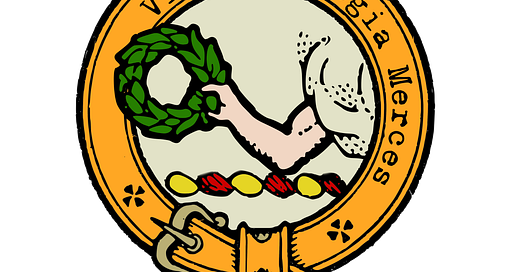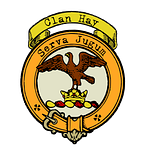Welcome back to the "A Clan A Day Podcast," brought to you by bagtownclans.com. I’m your host, Colin MacDonald, and today, we’re diving into the fascinating history of Clan Skene, a Scottish family with a story that reaches back to the time of Malcolm Canmore, filled with courage, loyalty, and deep ties to the land of Aberdeenshire. Clan Skene's origins, steeped in legend and war, take us on a journey through some of Scotland's most pivotal moments in history.
The Skene name, according to legend, traces its roots to a heroic act during the reign of Malcolm III, also known as Malcolm Canmore, in the 11th century. As the story goes, a younger son of the chief of Clan Donnchaidh—the clan later known as Clan Robertson—saved the king’s life by killing a fierce wolf with his sgian-dubh, a small knife or dirk. This brave act earned him a reward of land, specifically the area that could be covered by a hawk’s flight, which became known as the lands of Skene in the Forest of Stocket, Aberdeenshire. And thus, Clan Skene was born, with its name likely derived from the weapon that played such a crucial role in its origin. This act of bravery is immortalized in the clan's coat of arms, where three wolves' heads are depicted, impaled on daggers—a lasting reminder of the clan’s legendary founding moment.
Historically, the first recorded members of the clan appear in the late 13th century. John de Skene swore fealty to King Edward I of England in 1296 by signing the Ragman Roll, but his descendants would go on to support Scotland’s fight for independence. John’s grandson, Robert de Skene, shifted allegiance and became a staunch supporter of Robert the Bruce. For his loyalty, Robert was granted a charter in 1318, officially making the lands of Skene a barony. This was a significant moment in the clan’s history, securing their lands for future generations and aligning the Skenes with the rising tide of Scottish independence.
The clan's involvement in Scottish warfare continued throughout the centuries, often with tragic results. In 1411, Adam de Skene, a grandson of Robert, was killed at the Battle of Harlaw, a bloody conflict between the forces of Donald, Lord of the Isles, and the Earl of Mar. Nearly a century later, Alexander Skene, the 4th chief, was slain at the Battle of Flodden in 1513, fighting alongside King James IV in one of Scotland's most disastrous defeats at the hands of the English. The tragedy struck again when another Alexander Skene died at the Battle of Pinkie Cleugh in 1547, a catastrophic loss for the Scots in their fight to defend their lands from an English invasion.
Despite these losses, Clan Skene remained loyal to the crown. During the tumultuous 17th century, James Skene of Skene supported King Charles I during the English Civil War, but like many of the king’s loyalists, he was forced into exile. James found refuge in Europe, where he served under the famed Swedish King Gustavus Adolphus, known as the “Lion of the North,” during the Thirty Years’ War. Unfortunately, James died before he could return to Scotland, but his sons maintained the family’s lands and eventually adapted to the political changes following the Restoration of the monarchy.
By the 19th century, the direct male line of the Skene chiefs had died out. The family’s estates passed to a nephew, James Duff, the 4th Earl of Fife, marking the end of one chapter in the clan’s history. However, the Skene name and legacy lived on through several notable branches and figures. One such branch was the Skenes of Rubislaw, who included James Skene, a close friend of the famous novelist Sir Walter Scott. James Skene’s vivid sketches of Scottish localities were said to have inspired scenes in Scott’s novels Quentin Durward and Ivanhoe. Another illustrious member of the clan was William Forbes Skene, one of Scotland’s most respected historians, who was appointed Historiographer Royal for Scotland in 1881. His works on Celtic and Scottish history remain influential to this day, cementing the Skene name in the annals of Scottish scholarship.
Skene Castle, the ancient seat of the clan chiefs, stood as a symbol of their power and resilience for centuries. Built as a stone fortress in a time when wooden structures were still the norm, Skene Castle represented the enduring strength of the family. Though the direct line of the Skene chiefs may have ended in 1827, the family name continued through various cadet branches, with the Skenes of Hallyards emerging as the chief line.
In more recent history, in 1994, the Lord Lyon King of Arms officially recognized Danus George Moncrieff Skene of Skene as the Chief of the Name and Arms of Skene. This reinstatement of the chiefship symbolized a revival of the clan's heritage. Upon Danus’s death in 2016, his son Dugald Skene inherited the title, becoming the current chief and Baron of Skene, ensuring that the legacy of Clan Skene remains alive today.
The Skenes have contributed significantly to Scotland’s history, not only on the battlefield but also in the realms of literature, medicine, and law. Figures like Sir John Skene, a prominent legal scholar of the 16th century, helped shape the Scottish legal system, while James Skene’s connection to Sir Walter Scott gave the clan a place in Scotland’s rich literary tradition. And with historians like William Forbes Skene preserving the stories of Scotland’s past, the Skene family has made its mark in more ways than one.
That wraps up today’s exploration of Clan Skene. From their legendary beginnings to their contributions to Scottish culture and history, the Skenes have left an indelible mark on the nation. Join us next time for another journey through Scotland’s clan history here on "A Clan A Day Podcast." I’m Colin MacDonald, and as always, Go n-éirí an bóthar leat.













Share this post